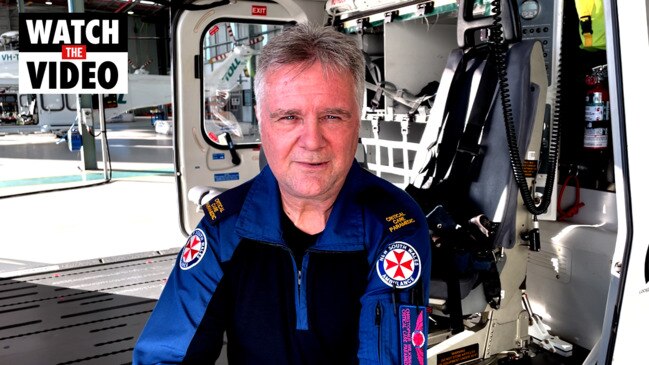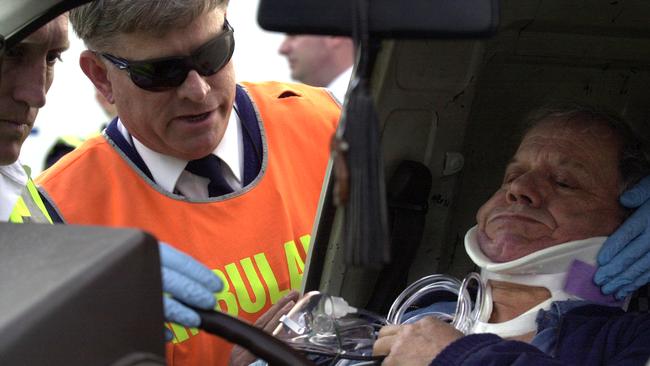Thredbo, Newcastle Earthquake: NSW’s longest serving paramedic Stan Harrold has seen it all
When the nation held its collective breath as Thredbo landslide disaster survivor Stuart Diver was pulled free, paramedic Stan Harrold was there supervising the dramatic rescue. This week he retired after 55 years on the job.

NSW
Don't miss out on the headlines from NSW. Followed categories will be added to My News.
As the nation held its collective breath as sole survivor of the Thredbo landslide disaster Stuart Diver was pulled free from the wreckage, paramedic Stan Harrold was there supervising the delicate operation.
The dramatic 1997 rescue of Diver - who survived 65 hours trapped between two concrete slabs in freezing conditions beside the body of his wife Sally - remains one of the highlights of the Chief Inspector’s 55-year career.

This week that distinguished career came to an end as Insp Harrold - the state’s longest serving paramedic - retired from the job he said he’d start over again in a heartbeat.
His has been a career of firsts - the state’s first intensive care paramedic, the first peer support worker, the first member of the special casualty access team.
All those skills would come into play at the catastrophic landslide, which killed 18 people.
“Rescuing a survivor was one of the things you hope for and you believe in, but when it came it was almost like a dream,” Insp Harrold said.

“For (Diver) to survive under there, in freezing temperatures, with his wife beside him .... it was very emotional.
“(Paramedic) Paul Featherstone stayed by his side, and (Diver) used my mobile phone to talk to his family once he was stable but before he got out - it was a unique feeling.”
More than a decade later, the veteran paramedic would supervise the rescue mission after one of Australia’s most serious natural disasters.
The 1989 Newcastle earthquake killed 13 people and injured more than 160, with the highest death toll recorded at the Newcastle Workers Club where the floor collapsed.

“Several times while we still had live people under the rubble in the club, there were minor tremors and we had to evaucuate - it was very traumatic for the frontline workers being told to leave,” he said. “I dont remember any of the injuries I saw, but I remember that.”
Insp Harrold’s ability to block out the horror of what he’s witness to is one of the coping mechanisms he’s developed over the decades.
“Going to a a job that’s upsetting visually, due to the violence, or smell wise or feelings wise - one of the things I’ve learnt to do is reframe jobs so when I look back later I think of the positive,” he said.
“It’s often the worst day of someone’s life and we endeavour not to make it worse so if we can walk away knowing we’ve given people care and compassion, or being satisfied we’ve saved a life, that’s what I’d like to remember.”

From the heroin crisis of the seventies and eighties to the scourge of Ice; the carnage of gangland wars and road trauma; through to escalating rates of mental illness and domestic violence - Insp Harrold has been front and centre. He’s even received an Ambulance Service Medal for his efforts.
He’s seen huge leaps forward in training and technology and amazing medical advances since he started in 1970 with little more than a first aid kit.

“We had one painkiller, some oxygen equipment, a splint - we couldn’t even take someone’s blood pressure or have a penlight torch to get a reaction from someone’s pupils,” he said. “When someone was bleeding to death internally there was nothing we could do. Now so many lives have been saved with better treatment and technology.
“When someone suffers a heart attack for instance we can do an early ECG in the back of the ambulance and send those results to a cardiologist at the hospital so the patient can go straight to the cath lab when we get there. So you can see a person who was knocking on death’s door walk out of the hospital two hours later.”
Insp Harrold has seen the best in people, and the worst of society too. Once considered “untouchable”, assaults on paramedics had risen in recent years.
“We’d walk into a crowd and it would part for us. If someone took a swipe, they’d realise and say ‘sorry, didn’t realise you were an ambo’,” he said.
“That’s changed. I’ve never been assaulted - though I’ve deflected a few.”
He’s seen colleagues attacked though, and along with the entire Ambulance service - and the community - he mourned the loss of paramedic Steven Tougher who was stabbed to death while on duty in April, 2023.
“We trust the public,” he said “Instead of locking himself in the car, he tried to help.”

The 77-year-old will spend more time with wife Debbie, daughter Gemma and his two grandkids in retirement, while continuing to help his former colleagues through NSW Ambulance Legacy.
And he leaves having inspired thousands of young paramedics; NSW Ambulance Commissioner Dominic Morgan among them.
“I remember as a young ambulance officer I was in awe of Stan,” Commissioner Morgan said. “I would quake in my boots if I had to do a ride-along with him.
“Yet he has this beautiful way of expecting the highest possible standards, while making you feel valued at the same time - and he’s done that for countless paramedics.”
Health Minister Ryan Park added: “To attend to people often at their most vulnerable and in the most harrowing circumstances, a paramedic is one of the toughest and most admirable roles in our community. Stan’s longevity in the position should inspire young and aspiring paramedics for generations to come.”
On Thursday, at his farewell at NSW Ambulance headquarters at Olympic Park, hundreds gathered to pay their respects, to shake his hand. As one paramedic told him, if a sticky situation arose, the question he always asked himself remained: “What would Stan do?”
Do you have a story for The Telegraph? Email lisa.wachsmuth@news.com.au





